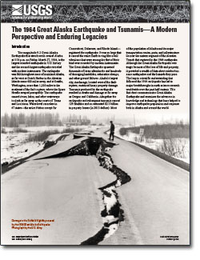The magnitude 9.2 Great Alaska Earthquake that struck south-central Alaska at 5:36 p.m. on Friday, March 27, 1964, is the largest recorded earthquake in U.S. history and the second-largest earthquake recorded with modern instruments. The earthquake was felt throughout most of mainland Alaska, as far west as Dutch Harbor in the Aleutian Islands some 480 miles away, and at Seattle, Washington, more than 1,200 miles to the southeast of the fault rupture, where the Space Needle swayed perceptibly. The earthquake caused rivers, lakes, and other waterways to slosh as far away as the coasts of Texas and Louisiana. Water-level recorders in 47 states—the entire Nation except for Connecticut, Delaware, and Rhode Island— registered the earthquake. It was so large that it caused the entire Earth to ring like a bell: vibrations that were among the first of their kind ever recorded by modern instruments. The Great Alaska Earthquake spawned thousands of lesser aftershocks and hundreds of damaging landslides, submarine slumps, and other ground failures. Alaska’s largest city, Anchorage, located west of the fault rupture, sustained heavy property damage. Tsunamis produced by the earthquake resulted in deaths and damage as far away as Oregon and California. Altogether the earthquake and subsequent tsunamis caused 129 fatalities and an estimated $2.3 billion in property losses (in 2013 dollars). Most of the population of Alaska and its major transportation routes, ports, and infrastructure lie near the eastern segment of the Aleutian Trench that ruptured in the 1964 earthquake. Although the Great Alaska Earthquake was tragic because of the loss of life and property, it provided a wealth of data about subductionzone earthquakes and the hazards they pose. The leap in scientific understanding that followed the 1964 earthquake has led to major breakthroughs in earth science research worldwide over the past half century. This fact sheet commemorates Great Alaska Earthquake and examines the advances in knowledge and technology that have helped to improve earthquake preparation and response both in Alaska and around the world.


